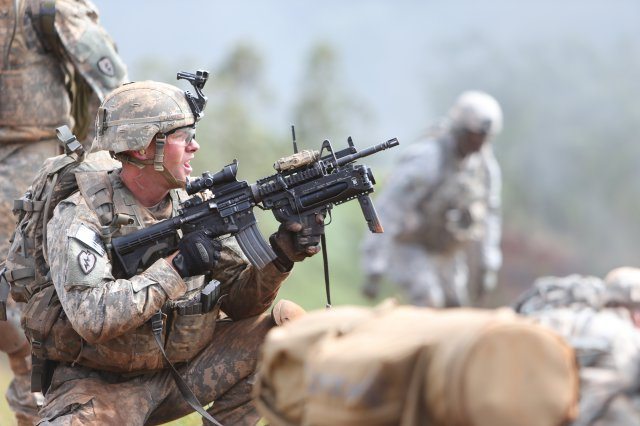Military analysts now have a tool that brings together unprecedented modeling and simulation features to help them better choose, or build weapons to overpower future threats.
Such features allow military researchers to analyze, for example, how a grenade, artillery round or any other weapon performs — or falls short — against moving targets in complex battlefield scenarios, which is one of the biggest challenges the military faces today.
With this information, researchers say, Army leaders can identify future technology investments early on, whether that is modifications to existing weapons or replacing them altogether.
“The Smart Weapon End-to-End Performance Model, or SWEEPM, developed by the U.S. Army Research Laboratory, known as ARL, is a set of files and software that cover all impacts associated with firing a round and anything that affects the delivery of that round,” said William F. Oberle, Ph.D., Advanced Weapons Concepts branch chief within ARL’s Weapons and Materials Research Directorate.
Oberle said the model’s versatility sets it apart from other force-on-force models that military planners use to practice sustained operations. With SWEEPM, as it’s called, researchers can model the overall effectiveness of all types of munitions throughout the entire target engagement, from target detection through damage estimation with a modular Monte Carlo simulation.
Using the model, researchers can look at a conceptual or actual guided artillery round, its guidance system and its performance, for example. Ballistic engineers provide information on how the round would be used in an attack, against a tank or truck for instance, and insight on the current inventory of the round. Other variables such as material composition of the round, muzzle velocity, how Soldiers aim and fire weapon systems, weather, stationary or moving targets are incorporated as part of a total system analysis that once encoded, helps researchers determine effectiveness scenarios, or situations that indicate the amount of damage the round causes.
“One of the missions of the Advanced Weapons Concepts Branch is to develop modeling and simulation tools to perform our performance/effectiveness analyses. Being able to perform these analyses in a timely manner requires that we look out and forecast what type tools we will need in the future,” Oberle said.
“In 2008, ARL recognized a void in modeling and analyzing smart weapon systems from target acquisition through damage estimation,” Oberle said. “Since a large segment of the divisions work in the future would involve smart weapons and no existing model could be found, we chose to start development of what is now termed SWEEPM.”
The Army completed SWEEPM in April 2013.
“It’s unique in that it was developed as a modular tool capable of being changed and adapted to model new concepts with minimal turnaround time,” said Mary K. Arthur, principle investigator who is credited with developing SWEEPM by discreetly integrating legacy and newly developed software.
SWEEPM currently employs two trajectory models, she said, a basic, fast-running 3DoF model used primarily in the development of SWEEPM, and a more complex, modified point mass model which includes a GPS navigation model and control forces for terminal guidance.
“Other submodels that can be easily changed out or modified include a target motion model, scout and rangefinder models, damage estimation models, and a recently added in-flight autonomous targeting model.”
Last month, SWEEPM was transitioned to the U.S. Army Armament Research, Development and Engineering Center’s, or ARDEC’s, System Engineering Directorate in Picatinny, N.J., on the heels of Army leadership’s renewed emphasis on force-on-force warfare, which had taken a backseat to counterinsurgency operations.
ARL and ARDEC are both elements of the U.S. Army Research, Development and Engineering Command, at Aberdeen Proving Ground, Md.
According to an ARDEC spokesperson, engineers there are in the midst of reviewing the tool for formal adoption, given the high performance computing, or HPC, capabilities of SWEEPM are of interest to the engineers and analysts at ARDEC.
“The ability to run SWEEPM on HPC assets at ARDEC allows for the stochastic evaluation of weapon performance by incorporating the real world randomness of target motion, target acquisition and projectile flight,” said Ingrid M. Dombroski, competency manager in ARDEC’s System Analysis Division. “SWEEPM is representative of the ever growing collaboration between ARDEC and ARL, where a shared need is met through the individual excellence of each center. In the case of SWEEPM, ARL brought forward their expertise in HPC; guidance, navigation and control, and target effects while ARDEC provided a world class user base for beta testing, programmatic support, and analytical and technical proficiency to meet a common Army need.”
Currently, ARL is using the model in a study requested by the Maneuver Center of Excellence at Fort Benning, Ga., to look at performance variables for the 40mm grenade. The center conducts research, development and experimentation to ensure our future maneuver force is prepared and equipped to fight and win in a complex future environment.
Plans are underway to incorporate the tool in an analysis of a conceptually guided artillery round, created by ARL designers, where control forces are going to be required to address hitting moving targets. The in-house concept will attempt to define requirements of an actual round to meet certain performance goals, and the results will be fed into programs managed by ARL’s Guidance Technology and Flight Science branches.
ARMY RESEARCH LABORATORY
ARL is part of the U.S. Army Research, Development and Engineering Command, which has the mission to develop technology and engineering solutions for America’s Soldiers.
RDECOM is a major subordinate command of the U.S. Army Materiel Command. AMC is the Army’s premier provider of materiel readiness — technology, acquisition support, materiel development, logistics power projection, and sustainment — to the total force, across the spectrum of joint military operations. If a Soldier shoots it, drives it, flies it, wears it, eats it or communicates with it, AMC provides it.











